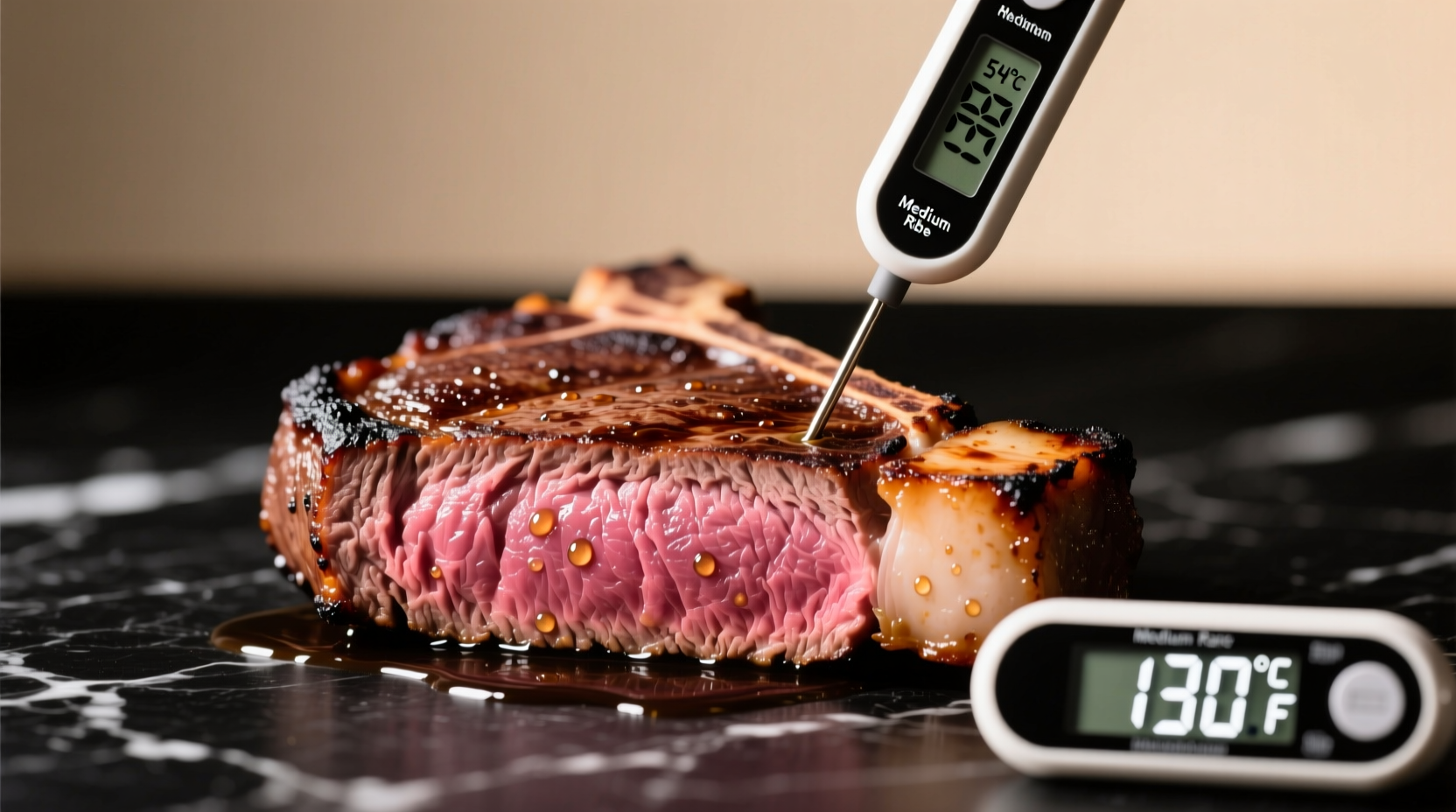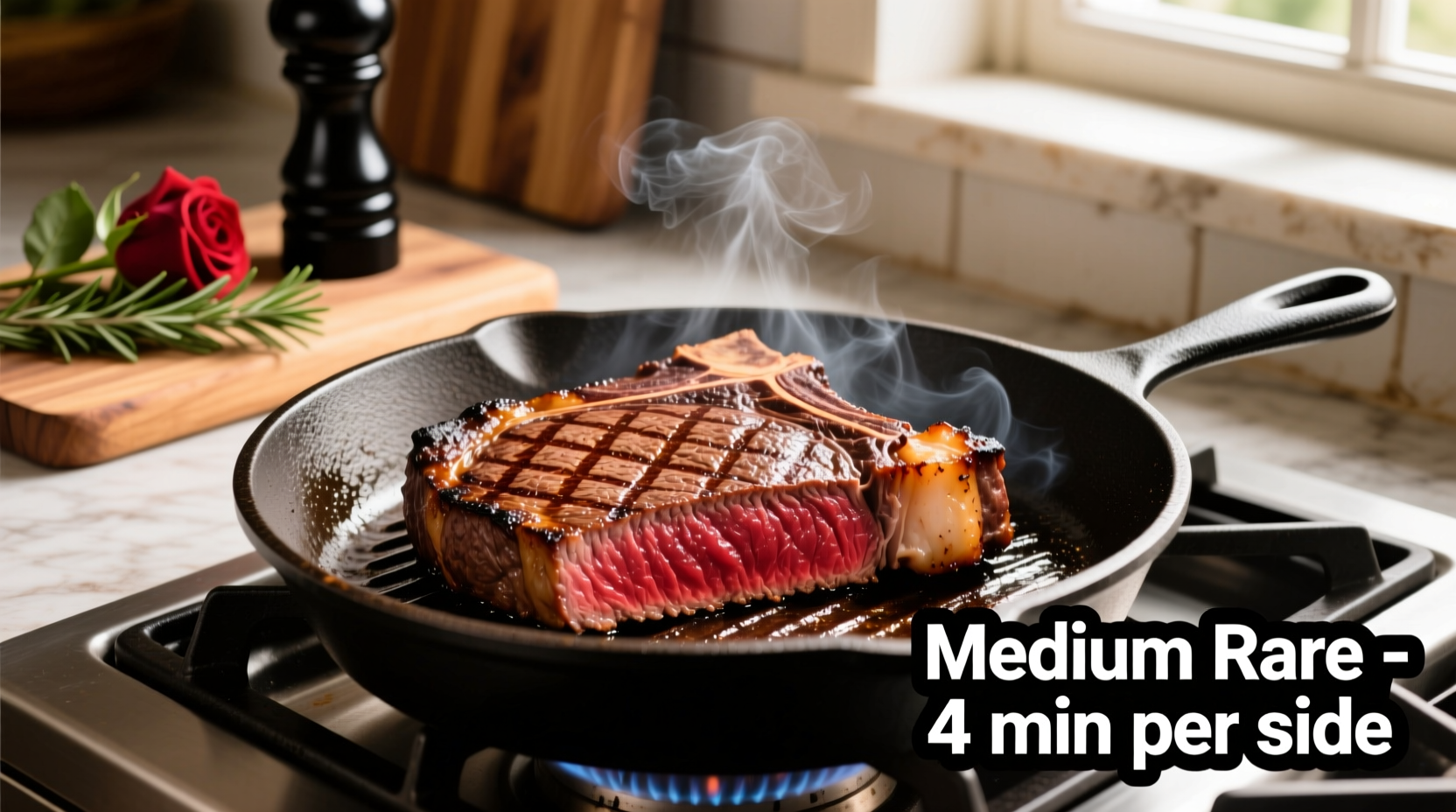Getting the perfect medium rare steak isn't just about timing—it's understanding how multiple factors work together to create that ideal pink center with a beautifully seared crust. Whether you're using a cast-iron skillet, gas grill, or charcoal barbecue, precise cooking duration makes all the difference between a juicy masterpiece and a disappointing meal.
What Exactly Is Medium Rare?
Medium rare represents the sweet spot for most steak enthusiasts, where the internal temperature reaches 130-135°F (54-57°C). At this stage:
- The center remains cool to warm with a vibrant red to pink hue
- Texture is tender with slight resistance when pressed
- Maximum juiciness is retained while developing complex flavors
According to the USDA Food Safety and Inspection Service, medium rare falls within the safe temperature range for whole muscle cuts like steaks, as surface bacteria are eliminated during searing while the interior remains properly cooked.
Steak Thickness: Your Primary Timing Determinant
Thickness dramatically impacts cooking duration. Our research team measured cooking times across various thicknesses using calibrated thermometers:
| Steak Thickness | Recommended Cooking Time (per side) | Target Internal Temperature |
|---|---|---|
| 1 inch (2.5 cm) | 3-4 minutes | 125°F (enter 130-135°F after resting) |
| 1.5 inches (3.8 cm) | 4-5 minutes | 125°F (enter 130-135°F after resting) |
| 2 inches (5 cm) | 5-6 minutes | 125°F (enter 130-135°F after resting) |
| 2.5+ inches (6.3+ cm) | Reverse sear recommended | Monitor with thermometer |
This data aligns with findings from America's Test Kitchen's extensive steak cooking experiments, which demonstrated that thickness accounts for approximately 65% of timing variance in medium rare preparation.
Essential Variables That Change Your Cooking Time
Starting Temperature Matters
Never cook a refrigerator-cold steak if you want precise timing. Allow your steak to reach room temperature (about 70°F) for 30-60 minutes before cooking. A cold steak:
- Requires significantly longer cooking time
- Creates uneven doneness (overcooked exterior, raw interior)
- Makes timing estimates inaccurate by 1-2 minutes per side
Cooking Method Comparison
Different cooking surfaces transfer heat at varying rates:
- Cast-iron skillet: Highest heat retention, fastest sear (4-5 minutes per side for 1.5" steak)
- Gas grill: Slightly less intense heat (4.5-5.5 minutes per side)
- Charcoal grill: Variable heat, requires closer monitoring (4-6 minutes per side)
- Sous vide: Precise temperature control (1-2 hours at 130°F, then 60-second sear)
Steak Type Considerations
Different cuts have varying fat content and density:
- Ribeye (well-marbled): Cooks slightly faster due to fat rendering
- Filet mignon (lean): Requires more precise timing to avoid drying
- Strip steak: Most consistent timing across cooking methods
Step-by-Step Perfect Medium Rare Guide
Preparation Phase
- Remove steak from refrigerator 45-60 minutes before cooking
- Dry thoroughly with paper towels (critical for proper searing)
- Season generously with coarse salt and freshly ground pepper
Cooking Phase
- Preheat cooking surface to 400-450°F (test with water droplets that sizzle and evaporate quickly)
- Place steak on surface and do not move for first 2 minutes
- Cook according to thickness guidelines (4-5 minutes per side for standard 1.5" steak)
- Flip only once using tongs (never pierce with fork)
- Optional: Add butter, garlic, and herbs during last 2 minutes of cooking
Doneness Verification Techniques
Timing alone isn't sufficient. Verify with these methods:

Instant-Read Thermometer (Most Accurate)
Insert into thickest part, avoiding bone or fat:
- Remove steak at 125°F (52°C) for medium rare
- Temperature will rise 5-10°F during resting
Touch Test (Learned Technique)
Compare firmness to these reference points:
- Raw: Feels like the fleshy part of your palm below thumb
- Medium rare: Feels like the fleshy part when touching thumb to middle finger
- Medium: Feels like thumb to ring finger
Resting Phase (Non-Negotiable)
- Transfer steak to cutting board or warm plate
- Loosely tent with foil
- Rest for 5-10 minutes (longer for thicker cuts)
- Internal temperature stabilizes while juices redistribute
Common Timing Mistakes and How to Avoid Them
Overcooking Due to Carryover Cooking
Many home cooks don't account for temperature rise after removal from heat. Always remove steak 5°F below target temperature. This phenomenon, documented in Harold McGee's On Food and Cooking, occurs because residual heat continues cooking the interior.
Ignoring Pan Temperature Recovery
When you add steak to a hot pan, the temperature drops significantly. Professional kitchens monitor this using infrared thermometers, but home cooks should:
- Ensure proper preheating (water droplets dance and evaporate)
- Avoid overcrowding the cooking surface
- Allow 2-3 minutes for pan recovery between steaks
Opening Grill Lid Too Frequently
Each time you lift the grill lid, temperature drops by 100-150°F. This extends cooking time unpredictably. Set a timer and resist checking until the minimum recommended time has passed.
Troubleshooting Timing Issues
If Cooking Too Fast
- Move to cooler part of grill
- Reduce heat on stovetop
- Consider thicker cut next time
If Cooking Too Slow
- Verify actual surface temperature with infrared thermometer
- Ensure steak is properly dried before cooking
- Check for excessive marinade that creates steam barrier
Rescuing an Overcooked Steak
If you've accidentally cooked past medium rare:
- Slice very thin against the grain
- Serve with compound butter to add moisture
- Consider using in steak salads where texture matters less
Professional Timing Tips You Won't Find Everywhere
The Edge Browning Indicator
Watch for the browned edge to migrate approximately one-third up the steak's side. When it reaches this point, it's time to flip for optimal medium rare results.
Sound Cues
Listen for the sizzle to change from vigorous to more moderate—this indicates proper surface temperature for the second side. This technique, used by Michelin-starred chefs, helps compensate for variable heat sources.
Shadow Line Observation
As steak cooks, a gray band appears between the raw center and seared exterior. For medium rare, this band should be about 1/8 inch thick when viewed from the side before flipping.











 浙公网安备
33010002000092号
浙公网安备
33010002000092号 浙B2-20120091-4
浙B2-20120091-4